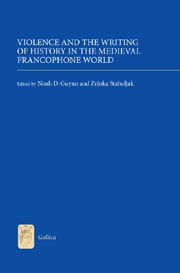Book contents
- Frontmatter
- Contents
- List of Illustrations
- List of Contributors
- Acknowledgments
- Introduction
- 1 Historicity, Violence, and the Medieval Francophone World: Mémoire Hystérisée
- Part I Theorizing Violence
- Part II Institutions and Subversions
- 4 Vice, Tyranny, Violence, and the Usurpation of Flanders (1071) in Flemish Historiography from 1093 to 1294
- 5 Marvelous Feats: Humor, Trickery, and Violence in the History of the Counts of Guines and Lords of Ardres of Lambert of Ardres
- 6 Dismembered Borders and Treasonous Bodies in Anglo-Norman Historiography
- 7 The Good, the Bad, and the Beautiful: Violence in the Canso de la Crozada
- Part III Gender and Sexuality
- Part IV Trauma, Memory, and Healing
- Index
- Already Published
7 - The Good, the Bad, and the Beautiful: Violence in the Canso de la Crozada
from Part II - Institutions and Subversions
Published online by Cambridge University Press: 05 April 2013
- Frontmatter
- Contents
- List of Illustrations
- List of Contributors
- Acknowledgments
- Introduction
- 1 Historicity, Violence, and the Medieval Francophone World: Mémoire Hystérisée
- Part I Theorizing Violence
- Part II Institutions and Subversions
- 4 Vice, Tyranny, Violence, and the Usurpation of Flanders (1071) in Flemish Historiography from 1093 to 1294
- 5 Marvelous Feats: Humor, Trickery, and Violence in the History of the Counts of Guines and Lords of Ardres of Lambert of Ardres
- 6 Dismembered Borders and Treasonous Bodies in Anglo-Norman Historiography
- 7 The Good, the Bad, and the Beautiful: Violence in the Canso de la Crozada
- Part III Gender and Sexuality
- Part IV Trauma, Memory, and Healing
- Index
- Already Published
Summary
The scene of violence described in the Canso de la Crozada is a terrible one. Ramon Roger, the Count of Foix, has attacked a group of Germans and Frisians, massacring them and mutilating those he did not kill by gouging out their eyes and cutting off their hands. Confronting the count at the Fourth Lateran Council of 1215, Folquet de Marseille, the Bishop of Toulouse, protests,
n'a tans mortz e trencatz e brizatz
e partitz que lo cams de Montjoy ne remas si crostitz.
…Laforas a la porta es tals lo dols e·l critz
dels orbs e dels nafratz e d'aicels meg partitz, que negus no pot ir si no lo mena guitz.
(145.18–23)[He has killed, slashed, broken, and mutilated so many that the field of Montgey remains covered with them.… Out there at the gateway rise the moans and cries of the blind, the wounded, men who have lost their limbs or cannot walk unless a guide leads them.]
Through Folquet's words, we have the impression of gaining access to a historical reality. Other sources from this time confirm that Ramon Roger did, in fact, ambush these men as they were traveling between Revel and Cuq-Toulza in April of 1211.
- Type
- Chapter
- Information
- Publisher: Boydell & BrewerPrint publication year: 2013



